It is hard to argue with 435 hp – whether behind the wheel or in the next lane over.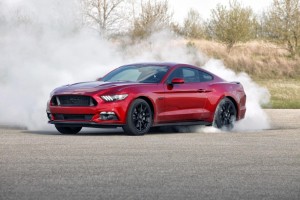
The new Mustang GT may have the smallest V8 of the three pony cars (the other two being the Chevy Camaro SS and the Dodge Challenger R/T) but its 5 liter V8 actually makes more hp than either of them.
Relative to the Challenger, especially. The poor thing’s 5.7 liter Hemi V8 doesn’t even crest 400 hp (375 with the manual; downrated to 372 if you go with the optional automatic).
And there’s no convertible Challenger, either.
The Camaro’s closer. SS models get a huge 6.2 liter V8, but it tops out at 426 hp – and the Camaro is 200 pounds heavier than the Mustang (3,908 pounds vs. 3,705 for the Ford).
Apparently, there is a replacement for displacement.
The Mustang is Ford’s perennial pony car – in continuous production since 1964. Unlike its two current rivals – the Chevy Camaro and the Dodge Challenger – both of which have been retired and resurrected like obsolete battleships.
The Mustang is also the only one of the three that’s truly a pony car. It is smaller – and lighter – than the hulking Camaro (and the even more hulking Challenger, which is nearly a foot longer overall and weighs 400 pounds more).
Those two – especially the Challenger – are muscle cars.
When Ford updated the Mustang for the 2015 model year, it did so with the world market in mind – not just the American market. This is why it is smaller, lighter and more export friendly (including an available turbocharged four cylinder engine) than its Born to Run (and born to drink gas) American market-only competition.
And yet, it still has every quality that makes a Mustang an American car.
Base price is $23,895 for the V6 coupe; $29,395 for a coupe with the stronger (and more fuel-efficient) “EcoBoost” turbo four. A GT coupe with the 5 liter V8 and six-speed manual transmission stickers for $32,395 to start.
The convertible GT with the optional six-speed automatic I test drove starts at $41,895.
WHAT’S NEW FOR 2016
A bunch of packages, including California Special for the GT (black powder-coated 19-inch wheels, bigger trunk spoiler and different trim) and a Pony package (also with special 19-inch wheels) for Mustangs with the mid-level turbo four-cylinder engine.
There’s also a new retro-inspired integration of the secondary turn signal indicator lights into the rear-facing hood vents – a feature last seen in classic Mustangs of the late ’60s and early ’70s. You can also order all but base V6 coupes with a contrast color black painted roof.
But the biggest update is the ditching (thank the Motor Gods) of the smash-it-with-a-ball-peen-hammer MyFord Touch LCD interface in favor of a redesigned and much easier-to-use Sync3 system.
More engine options than the competition.
More engine than the competition.
Less bulk (and weight) than the competition.
Electric line-lock (GT) and in-car 0-60 and quarter-mile timer (all trims, even base V6).
An Aikido master… among bar-room brawlers.
WHAT’S NOT SO GOOD
Pull-up emergency brake is on the wrong side of the center console and set up to be useless (not enough tension on the cable) for making 90 degree course corrections.
Performance Package (with more aggressive final gearing, firmer suspension settings, upgraded brakes and cooling system, plus extra gauges, not available with the base V6.
GT’s optional six-speed automatic does rev-matched downshifts, but doesn’t bark the tires on full-throttle upshifts. All muscle cars with automatics should do this.
You can get a convertible … but not T-Tops (because Uncle).
The Mustang is an unusual bird (er, horse?) in that it alone offers three available engine choices. Camaro and Challenger come with either of two engines – neither of them unexpected or unusual for cars of their kind.
Base Mustang coupes (and convertibles) come with what you’d expect: a biggish V6 (3.7 liters) that makes a pretty solid 300 hp. You should re-read that.
And, marvel.
The base Mustang’s V6 engine makes as much or more horsepower as most classic-era Mustang V8s made, back in the day. For instance, a 1965 GT’s 289 (5 liter, roughly) “High Power” V8 made a rated 271 hp. See here if you dinna believe me.
That was with a rough-idling solid lifter camshaft and a thirsty four barrel carburetor.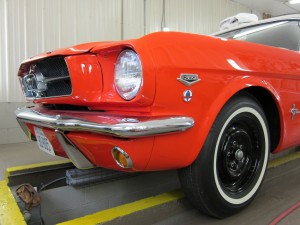
No AC, either.
And – by modern standards – a ’65 GT 289 Hi Po was slow. Seven seconds to 60; mid-fifteens through the quarter mile. The base-engined V6 Mustang can do that … without a rough-idling camshaft or a four barrel carburetor.
With AC.
And deliver almost 30 MPG (28, to be precise) on the highway.
Next up is a smaller – but even stronger – turbocharged 2.3 liter four cylinder engine. It produces 310 hp and 320 ft.-lbs. of torque.
This is more hp (and torque) than 4.6 liter V8 GTs made in the ’90s.
In fact, it is more hp (by 10 hp) than the competition-only ’95 SVT Cobra R had (300 hp from a 5.8 liter V8) and it’s nearly as quick: 5.8 seconds to 60 vs. 5.4 for the Cobra R, which was a stripped-down lightweight (no AC, no stereo, no power windows, no insulation) competition-only model sold to people with SCCA road racing licenses who meant to run the things on the race track.
The turbo’d ’16 Mustang is a high-line street car, with AC, power windows, cruise and plenty of insulation.
It’s also capable of 32 on the highway – and its city number (22 with the six-speed manual, 21 with the optional six-speed automatic) is better than the old SVT Cobra R’s highway number.
The ’95 also stickered for $30,000 (if you could lay your hands on one; they only made 250) which is about $47k in today’s Bernanke Bucks. In other words, about $17k more – for a tweaked out, barely street-drivable race car that was only slightly quicker than the current fully dressed street car.
And then we have the GT.
Really, everyone ought to stand up and clap.
435 hp out of 5 liters and doesn’t even seem like it’s trying too hard deserves that. The much larger (6.2 liter) Chevy V8 makes less power (426 hp) and the also-larger (5.7 liter) Chrysler Hemi makes much less (375).
Ford got hammered back in the ’90s and through the early 2000s for dropping the 5.0 (and 5.8) V8s, which were traditional (for muscle cars) overhead valve/pushrod designs like the current Chevy and Chrysler V8s, in favor of the “modular” (and overhead cam) 4.6 and 5.4 V8s, which were both horsepower and torque deficient relative to the bigger displacement (and still pushrod-actuated/two-valve) V8s on the GM and Chrysler side of the aisle.
Well, this fixes that.
The 5.0 Ford’s power output is best in class – and its torque output nearly so.
Worth a mention is that despite its smaller displacement, the Ford’s torque peak of 400 ft.-lbs. actually occurs lower in the powerband (at 4,250 RPM) vs. the Chevy 6.2’s 420 ft.-lbs. (at 4,600 RPM).
So it (the Ford) feels stronger sooner – especially since the Mustang is 200 pounds lighter than the fatty Camaro.
The manual-equipped GT can do the 0-60 run in 4.5 seconds. It happens so quickly – and so quietly – you’ll find yourself double checking the Track App timer. The reason being the Mustang’s 435 hp are very muffled hp. If there’s a bitch to register here, it’s that Ford over-muffled this magnificence. A set of Flowmasters would be the first addition I’d make if this were my car.
The GT’s time, incidentally, is more than 1 full second quicker than the fearsome-looking (and tough-sounding) but tepid performing Challenger R/T. Which is a staggering 400 pounds heavier than the GT Mustang and shy 60 hp, too.
Ten or 20 years ago, its 375 hp would have been impressive.
Yes, yes… you can one-up the Mustang by going with the SRT8 version of the Challenger (and, of course, the 707 hp Hellcat). Ditto the Camaro Z28 (7 liters, 505 hp) and the even stronger ZL1 (supercharged 6.2 V8 and 580 hp).
But now you’re looking at much more money; in the case of the Hellcat and the Z28, twice the price of the GT – so the comparo’s not fair. Besides which, Ford answers back with the Shelby GT350. Ferrari-style flat plane crankshaft, 526 hp at 8,200 RPM … for just under $50k.
Makes the ol’ ’95 Cobra R seem pretty loose-toothed.
Have you driven a Ford lately?
The first thing you notice, from behind the wheel, is that you don’t feel as though you’re commanding a U boat and viewing the world from a periscope.
In the Camaro, you do.
You sit hunkered low, your eyebrows just barely parallel with the door tops, the claustrophobic feel enhanced by the Chevy’s “chopped” roofline.
In the Mustang, you can rest your left elbow on top of the door sill with the window down.
I can do this in my Trans-Am, too. But it is 40 years old, from a different era. Before side-impact standards caused door tops to rise to the roofline, almost. The Ford complies with all the federal rigmarole, though – and does it without making you feel as though you are a five-year-old sitting in a bathtub.
Both the Camaro and the Challenger are big cars. For coupes, they are enormous. By today’s standards – relative to cars, generally – and in comparison with the muscle cars of antiquity.
My ’76 Trans-Am, once again. Considered overweight and too big in its day, is a small – almost puny – car compared with the new stuff.
Well, compared with the new Challenger and Camaro.
The TA’s wheelbase of 108 inches is almost Fiat 500-like vs. the Challenger’s 116 inch wheelbase (virtually the same as a current Lexus LS460, a full-size luxury sedan) and 4,000 pounds (empty) curb weight. And the Camaro’s a 275 pound offensive lineman compared with my old Pontiac’s 190 pound field goal kicker.
The Mustang is – by far – the nimblest and most pony car-feeling of the three. Objective measures in support of this thesis include its much tighter turning circle (36.5 feet) vs. the Challenger’s Lusitania-like (38.1 feet) and the Camaro’s 37.7 feet.
The fact that it is also several inches shorter overall (nearly a foot shorter overall vs. Challenger) is another metric of pony car-ness as opposed to the muscle car-ness of the Chevy and the Dodge.
And yet, the muscle car is still there.
Under your right foot, that is.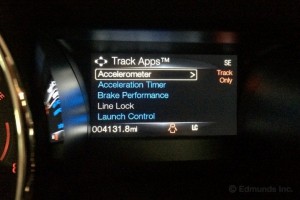
Use the little keypad on the steering wheel to dial up the Track Apps. Select 0-60, then flip the toggle switch in front of the shifter lever to Race (yellow helmet will illuminate). Then light ’em up and hold on. A bit more than four seconds later you will be past 60 and on your way to 80 about two seconds after that. Keep the pedal to the metal and you’ll clear the quarter mile in the high twelves at around 112 MPH.
This is serious speed.
Which it should be, given 435 hp.
Recall: This thing has 135 more hp than the race-car ’95 Cobra R.
Plus, the ’95 didn’t have an onboard line lock (to “warm” the rear tires… translation: Smoke ’em until you dig ruts in the asphalt, if you want to) and – trust me – this one feels a lot more stable at triple the speed limit than the now-ancient and long-in-the-rearview Cobra R did. I drove one at 137 MPH through the Baltimore Harbor Tunnel at 2:20 in the morning on my way up to New York City once upon a time, a long while ago… the 351’s exhaust pulses reverbing off the white tile walls.
That was fun, but this one’s fiercer. 137 is just warming up. Fourth gear.
Trust me.
The manual’s the way to go in a car like this, but the six-speed automatic is a great box, too. It grows a three-day stubble and gets downright belligerent when in Sport (and more so Race) mode, rev-matching and simulated double-clutching like your very own electronic Jeff Gordon. The one thing it doesn’t do – and could and should – is break the tires loose on a full-throttle first-second upshift. My old Trans Am can do that – and there’s a lot less than 435 hp under its hood. Every muscle car with an automatic ought to be able to chirp the tires. It’s like ketchup and fries. The two things just go together.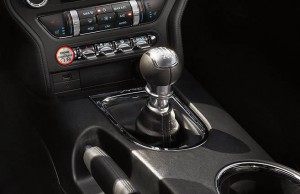
Thanks to deep overdrive gearing, the Mustang is as relaxed at highway speeds as your spinster aunt’s Camry – and if you don’t indulge yourself too much, the car is capable of better than the EPA rated 15 city/25 highway (manual; automatics score 16/25). Which is astounding, when you stop to think about it.
I mean the fact that you are behind the wheel of a 435 hp/12-second-quarter-mile car that’s as easy to drive as your spinster aunt’s Camry.
But a whole lot more fun.
While the Camaro and the Challenger each try to resurrect a particular year of their namesake’s classic antecedents (1969 for the Camaro; 1970 for the Challenger) the Mustang borrows elements and affectations from early and later classic Mustangs and successfully blends these elements into a coherent whole.
It doesn’t look like a reconstituted ’65; it’s too fluid, too sleek. But then, it doesn’t quite look like a ’73, either – even though there are echoes of that model (and the ’65) and others in between.
They – the designers – did a top drawer job making a modern-looking car that’s also instantly recognizable as a Mustang.
Check the dual breadbox dashpad; the retro font on the gauges. The chrome ball vents and metal-finish toggles.
But what you really notice is that nothing looks cheap or cheesy. This is a nice car, pony car or muscle car.
It’s also a well-packaged car.
Remember the stuff above about the smaller overall size of the Mustang relative to its rivals? And yet, it has a decent-sized trunk (13.2 cubic feet vs. Camaro’s 11.3) and significantly more legroom up front, for the driver (44.5 inches) than the Camaro’s got (42.4 inches).
Even the back seat is more accommodating in the Ford – especially width-wise. It gives your passengers 52.2 inches of shoulder room back there vs. 50.4 in Camaro.
The Challenger – being a full-sized coupe and the most massive of the three – beats both the Mustang and the Camaro when it comes to rear seat legroom (33.1 inches vs. 30.6 for the Ford and 29.9 for the Chevy) as well as trunk space. The Dodge has a true Goodfellas-style stuff-the-corpse back there 16.2 cubic footer. But it’s also much slower than either unless you up-rate it to SRT or Hellcat status – and pay through the nose accordingly.
It’s lucky that the base V6 is more powerful than most classic-era Mustang V8s were… because today’s Mustang V8 is damned near unaffordable if you’re in the target demographic (young male, under 35). This is just as true of the V8 versions of Camaro and Challenger.
Back in the day (late ’60s/early ’70s) you could buy the V8 version for about what it costs today (in inflation-adjusted dollars) to buy the base V6 versions of the current cars. The upside is that not only do the current versions come with a lot of engine, they come with a lot of other stuff that was most definitely extra back in the day – including AC, a leather-wrapped (and tilt-telescoping) steering wheel, all the power accessories and an audio system (six speakers, USB ports, Bluetooth) and an LCD touchscreen.
You even get a limited slip axle, no extra charge.
Both the base V6 and the next-up Ecoboosted version (see here for a full review) not only give you a lot of performance as-is and for the money, they each have a lot of potential. The turbo’d four version, especially. It’s much lighter – and with some aftermarket wicking up of the boost, probably the thing could run with a V8 GT while also running under the insurance mafia’s radar.
THE BOTTOM LINE
There’s an old country song – about a different car – that could just as easily be sung about the Mustang: Long and lean, every young man’s dream… she turned every head in town!
Please consider supporting EPautos.com
We depend on you to keep the wheels turning!
Our donate button is here.
If you prefer not to use PayPal, our mailing address is:
EPautos
721 Hummingbird Lane SE
Copper Hill, VA 24079
PS: EPautos stickers are free to those who sign up for a $5 or more monthly recurring donation to support EPautos, or for a one-time donation of $10 or more. (Please be sure to tell us you want a sticker – and also, provide an address, so we know where to mail the thing!)


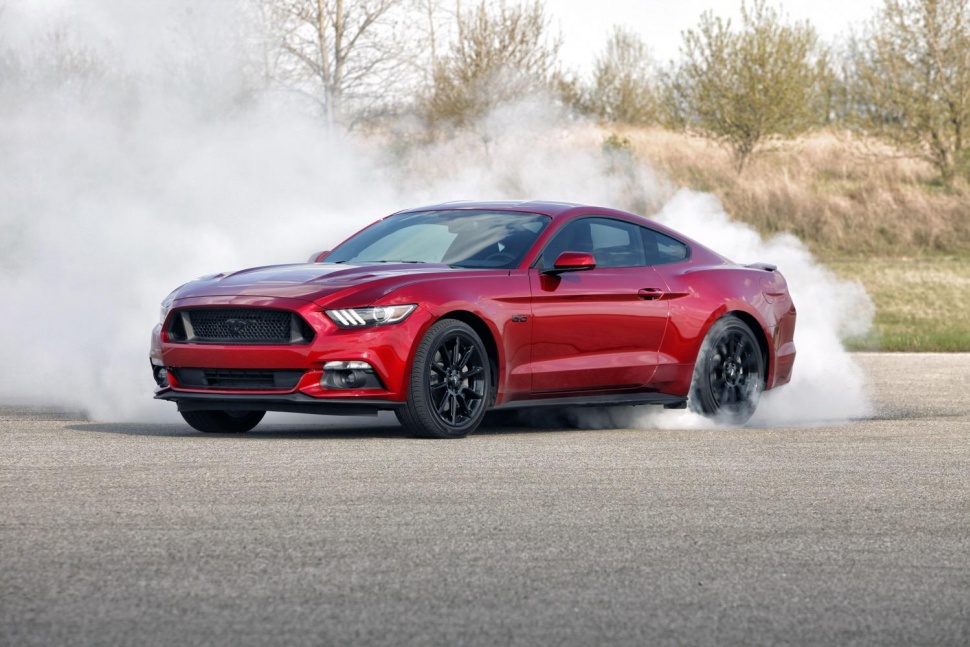



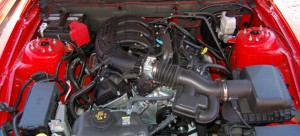
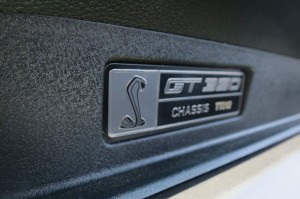

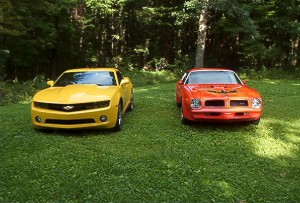
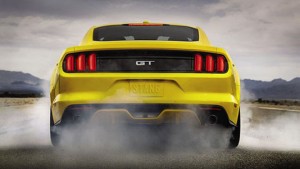









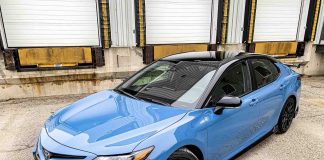
I drive a 2015 V6 automatic, my wife doesn’t drive standard, and she argued that she will want to drive it sometimes (she is afraid of it, so she doesn’t, so I win that argument next time I get a new car).
I leave it in “sport” mode at all times, and I shift with the paddle shifters. It definitely gives me the feel that I want from a muscle car. I feel like I could put a nicer exhaust and a tuned cold air intake in this ride to put it over the top.
I’ve never driven any other V6 that made me feel as good as this car does.
When I got married I had to teach my wife how to drive not only a 4 speed but a car with high speed rear gears and a close ratio gearbox, a 70mph+ 1st gear speed. It was a bit tricky starting off what with the Duntov cam and the Schiefer racing clutch. I’ll never forget the first time she pushed that clutch in and fired it up. It was all loud, staccato exhaust, shaking shaking body and a clutch that wanted to be disengaged or engaged but not slipped for a smooth take-off. She tried to shift it like it was a big block with an RV cam and old Duntov didn’t like that one bit. She couldn’t get the on throttle-off throttle thing worth a damn so it was herky-jerky, tire spinning or kill it sorta thing. She never could get used to spinning the tires on take-off since there wasn’t much else you could do. I saw the writing on the wall so right after we got married I changed the cam to a bit milder hydraulic unit. That was about all I could do without changing the clutch. She finally got pretty good at it and now and again I hear her get into it some, not like I would be enough to smooth it out and make the gear change smoother.
Cold weather came around and I used a company truck. Since the heater core was holed I had the line make a circle back to the return. It was colder than a witche’s titty that year and she wanted to use it but wasn’t big on no heat. She asked one day if she could do anything to make the heater work. I told her I had a new core in the trunk but I’d been working dark to dark harvesting and didn’t feel like putting it in after one of those days. She wanted to know if it was hard to do. I explained to her you could get it out by removing the inner fender and letting it set over the front tire. Take the bolts out holding the outside housing for the core and put the new one in and hook both heater hoses to the input and return lines sticking out. She showed up one afternoon toasty with the heater going and new 50/50 coolant in it. Good girl. not bad for a 19 year old raised with no father in a house full of helpless women.
Came across this this evening. Thought it would amuse a few of you.
https://www.youtube.com/watch?v=Az_gECAGXvE
FYI,
Ford limits throttle response in the Mustang for safety. During 1st and 2nd gear, the ECU limits the electronic throttle body to keep the rear tires from spinning during hard acceleration. Ford Racing sells a handheld tuner that removes this restriction and adds 60+ lb/ft of torque.
When I sold Fords this was by far my biggest complaint… this causes a herky-jerky driving experience when driving in 1st and 2nd gear.
I haven’t been going to the dragstrip much lately (to see for my self) but I still talk to one of the guys that works the starting line fairly often and he was telling me that the newer 5.0 stangs like to munch rearends on the launch. Wonder if there is a connection to this handheld tuner or non-stock tunes in general?
One of the ‘tuned’ 5.0 stangs I ran against last year was struggling to get into the 13’s due to ridiculous wheelspin (and a crap set of Nittos). Watched a GT500 run a 16 something one pass due to the same problem…probably both noob drivers though.
I recall a decade or so ago that Ford advertised Mustangs with the old drive it to work weekdays and race on the week-ends with a special “racing” package so that’s what people did. I can’t recall the part that kept giving it up, seems like the clutch or transmission but Ford started checking their computers and saying they were racing them and that voided the warranty. It was a big stink as it should have been. Seems like a big suit stopped their duplicitous ways.
Of course GM and Chrysler just advertised them with the old “don’t do this, professional driver, closed road course” and showed people driving the hottest hot rods they had like grandma but with big smiles……although at that time I’m not sure either one had a hot car besides the ‘Vette and Viper.
Different things are being melded together.
People were altering the programming to squeeze a few more hp out of the cars and some were getting detonation in cylinder 8 ruining the engine and then trying to claim it under warranty.
The racing thing was the BOSS 302s. using the ‘race key’ voided some aspects of the warranty.
Mustangs with the live rear axles will destroy their rear ends after a few hard launches on drag tires (GT500’s are notorious for this).
The modern 8.8 inch Ford rear end housing is surprisingly stout but the axles are the weak point. I haven’t heard of any problems with the brand new IRS Mustangs. Usually in IRS cars the differential is not the weak point…it’s the axle shafts and CV joints then shortly after the transmission itself.
All of the 2015+ IRS Mustangs running 9’s or faster have upgraded axles as far as I’m aware. The V-8 Camaros require a whole new drivetrain if you plan to run on drag tires with the only exception being the factory supercharged ZL1. That car has an upgraded Transmission, rear end and axles to handle drag launches with drag tires.
So they are still using 28 spline axles in the non-irs mustang 8.8s? The old explorers got 31 spline axles with way less than 400 horse…..
Thanks Eric for the detailed look at the new Mustang. The new look is growing on me. It definitely looks fast, even just sitting there. Bummer the exhaust note isn’t a bit more loud. Ford should be proud of this car, and let the world know that 5.0 V8 they are known for means business! I agree with you on the Camaro. I haven’t sat in a Challenger, but the Camaro I can’t stand. I am tall, and feel very claustrophobic in it. Hardly any glass area, and you feel like you are being only allowed to peak above the dash. The Mustang looks spacious and the fact that Ford is staying with its roots says a lot about why this pony car almost has a romantic quality to it.
For only $122,000 you can buy a Merc with your choice of 4 exhaust modes. Then there’s tax, gas guzzler, insurance, etc. I saw someone, and I couldn’t tell if it was male or female, getting a ticket in a Camaro from two DPS (two cars too)last week. I was viewing from a big rig and couldn’t tell, just saw the top of a head. I wondered if they stopped it for being a driverless car and how that person could see the road. That’s ridiculous.
No first to second tire chirp with the automatic GT?
Obviously, there’s more than enough power to make that happen. Probably intentional programing of the engine or transmission. What were they trying to achieve….or avoid?
Either way, it seems out of synch in a car that includes line lock. 😉
PS. This is the “only” new car I’d really like to buy.
They look fast sitting still, something I don’t get from the competition. One of the few vehicles I see getting driven fast too.
Great review Eric. Ford has been doing a bang-up job with the Mustang lately, and this year they seem to have left the competition in the dust. I can especially relate to the superior visibility from inside the Ford relative to its Chevy counterpart.
Thanks, Escher!
I’ll miss this one when they come to pick it up…